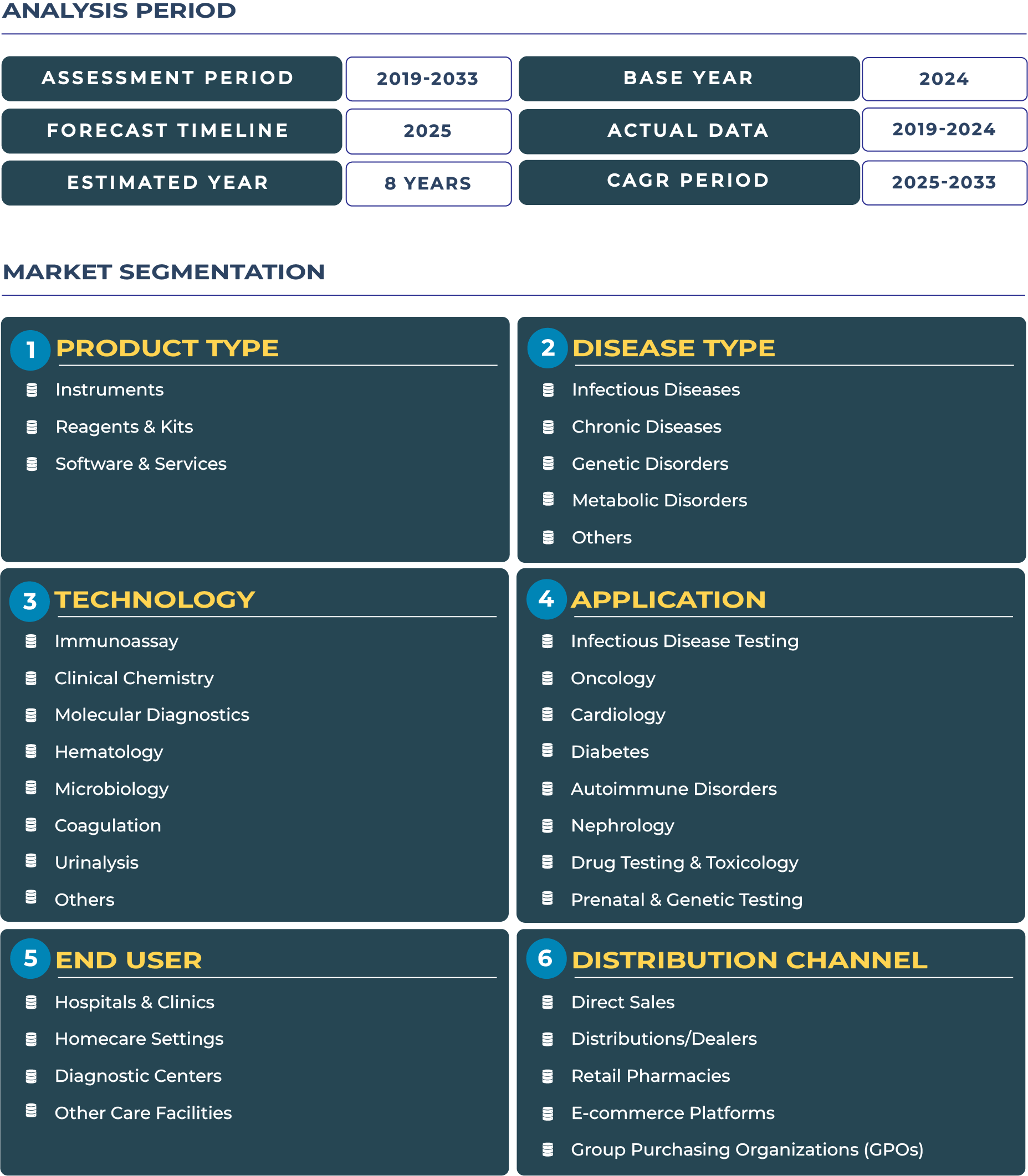Australia’s Dual Healthcare Model Catalyzing Precision in the In-vitro Diagnostic Market
Australia’s dual healthcare framework , an equitable mix of universal public care through Medicare and thriving private health insurance , is propelling the nation’s in-vitro diagnostic (IVD) landscape into a new phase of precision medicine and early disease detection. This balance has enabled both public and private providers to invest in diagnostic innovations that optimize patient outcomes and clinical efficiency. With a strong emphasis on preventive healthcare, aging population management, and chronic disease surveillance, the Australian IVD ecosystem is becoming a cornerstone of its broader digital healthcare transformation.
In 2025, the Australia In-vitro Diagnostic Market is estimated at USD 1.95 billion and projected to reach USD 3.19 billion by 2033, growing at a CAGR of 6.3% during 2025, 2033. This robust performance reflects consistent technological adoption across both reagent-driven testing and software-enabled diagnostics. Factors such as high per-capita healthcare spending, strong hospital infrastructure, and government incentives toward precision diagnostics have been instrumental in maintaining this steady expansion trajectory.
Market Outlook: Precision Healthcare Anchored in Public-Private Balance
The Australian IVD market is witnessing a structural evolution, supported by its unique healthcare financing model that encourages both accessibility and innovation. Public hospitals ensure baseline diagnostic coverage for all citizens, while private facilities accelerate the adoption of premium testing technologies, including AI-assisted imaging, genomic assays, and high-throughput reagents. This duality supports the market’s resilience even amid global supply challenges and macroeconomic volatility. Increasing collaboration between public laboratories and private diagnostic chains is bridging rural diagnostic gaps, ensuring equitable healthcare outcomes across remote regions such as Northern Territory and Tasmania.
Moreover, the government’s focus on strengthening healthcare resilience post-pandemic is fostering regulatory harmonization for faster diagnostic approvals through the Therapeutic Goods Administration (TGA). As Australia deepens its commitment to precision diagnostics and personalized medicine, IVD companies are leveraging cloud-based analytical tools and software-driven assay management systems to enhance clinical decision-making and reduce laboratory turnaround times. The result is a market that not only grows quantitatively but also evolves qualitatively toward integrated and data-centric care delivery.
Market Drivers & Restraints: Balancing Access, Regulation, and Innovation
Growing Demand Driven by Aging Population and Advanced Diagnostic Infrastructure
One of the major growth catalysts in the Australian IVD industry is its rapidly aging population, with over 16% of citizens aged 65 and above. This demographic shift is directly linked to higher demand for chronic disease testing, cancer screening, and personalized treatment monitoring. Additionally, Australia’s healthcare expenditure surpasses USD 200 billion annually, enabling hospitals and diagnostic centers to invest in next-generation reagent kits, immunoassay analyzers, and molecular testing platforms. Private hospital networks such as Ramsay Health Care and Sonic Healthcare have accelerated their adoption of automation in laboratory services to improve diagnostic throughput and accuracy. Furthermore, software-enabled diagnostics are gaining prominence in major urban centers like Sydney and Melbourne, facilitating data integration and interoperability within hospital information systems.
Challenges Rooted in Geographic Dispersion and Regulatory Complexity
Despite promising growth, the market faces several structural challenges. Australia’s vast geography limits access to high-end diagnostics in remote provinces. Rural laboratories often struggle with supply chain delays and a shortage of skilled lab technologists. Moreover, extended listing timelines under the Pharmaceutical Benefits Scheme (PBS) and procedural complexities within the TGA can slow down the introduction of novel diagnostic reagents and kits. Public hospitals, which operate under stringent cost-control frameworks, also face procurement-related price pressures that limit adoption of advanced diagnostic instruments. These challenges collectively highlight the need for targeted policy interventions to harmonize pricing, expedite regulatory clearances, and expand digital diagnostics into remote healthcare networks.
Trends & Opportunities: Toward Digitized, Decentralized, and Data-Centric Diagnostics
Emerging Trends: From Hospital Labs to Connected Diagnostic Ecosystems
The Australian IVD sector is increasingly defined by decentralization and connectivity. Diagnostic networks are transitioning from traditional hospital-based testing toward point-of-care and ambulatory service centers (ASCs). This trend is particularly prominent in metropolitan areas like Brisbane and Perth, where outpatient diagnostic facilities are leveraging telepathology and AI-powered image analysis. Integration of tele-rehabilitation and tele-consultation platforms with diagnostic data enhances remote patient monitoring, particularly for oncology and cardiovascular care. Additionally, private insurers are negotiating value-based care models where reimbursement is linked to diagnostic outcomes, incentivizing accuracy and efficiency in testing workflows.
Key Opportunities: Rural Outreach, Digital Integration, and ASC-Centric Solutions
The most promising opportunities in the Australian IVD landscape lie in rural and ASC-focused strategies. Companies are introducing bundled diagnostic offerings tailored for ASCs, combining reagents, consumables, and software for seamless testing integration. Tele-diagnostic pilots supported by regional health authorities are extending IVD accessibility across Western Australia’s remote areas. Furthermore, partnerships with Key Opinion Leaders (KOLs) and rural medical associations are fostering localized training programs and awareness campaigns. The convergence of cloud analytics, reagent innovation, and government-funded health digitization initiatives presents a long-term growth horizon for diagnostic companies seeking to scale sustainably.
Competitive Landscape: Global Leaders Strengthening Local Footprints
The Australian IVD market is characterized by a healthy mix of global giants and regional players. Major international firms such as Roche Diagnostics, Abbott, and Siemens Healthineers have established strong operational bases in Australia, providing hospitals with comprehensive diagnostic instruments, reagents, and software platforms. Local firms like Sonic Healthcare complement these global leaders through their extensive laboratory network and localized testing services. In 2024, Siemens Healthineers launched advanced molecular diagnostic platforms in Sydney, enhancing precision in infectious disease testing. Similarly, Roche expanded its digital pathology portfolio across major Australian laboratories to streamline cancer diagnosis workflows. These developments demonstrate how companies are aligning their strategies with Australia’s digital health agenda to sustain long-term competitiveness.







